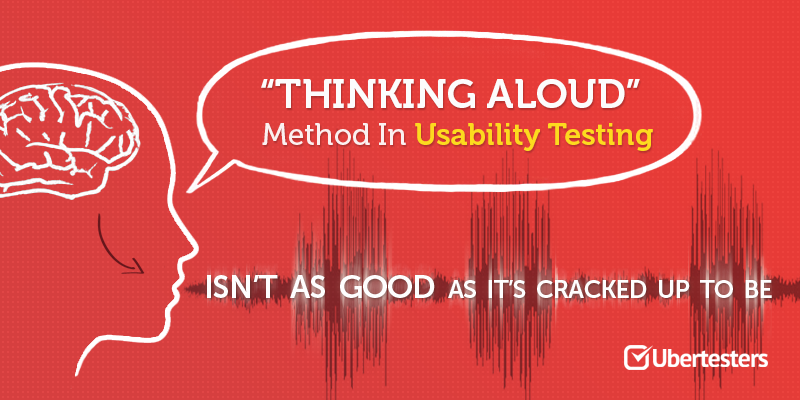‘Thinking Aloud’ Method In Usability Testing

“Usability testing is more than a just a checkbox on a list of product requirements — it is the most convincing support for your design decisions.” - The Guide to Usability Testing
You may produce really great carefully-planned product with dozens of unique features and special offers that, as you think, will make your customers’ life easier and happier. However, all your efforts may turn out to be futile if your users cannot use your product because it is too complicated or incomprehensible. That is why performance of usability testing is the best way to avoid any issues connected with user interface.
Advantages of usability testing:
- It helps to discover those bugs that had not been noticed by the developers or had been missed during the performance of other types of testing.
- In the process of usability testing the quality of product is getting better, the interface is also improving. Therefore the product is accepted more readily by the end users and your CLV (Customer Lifetime Value) goes up.
- It can help to fix the issues users can experience even before the release of the product.
There are many various methods of usability testing, each of them can do a lot of good for improving of your product, but let’s turn our attention to evaluation methods as the most widely used methods for testing your product’s usability.
Usability evaluation methods
The term usability evaluation methods is used when we deal with methods or techniques that are used for performing usability evaluation that can focus on:
- evaluation that is done in the process of the development so that the design can be improved (formative evaluation);
- evaluation that is performed after the development and has aim to assess the design (summative evaluation)
To put it more simply, formative evaluation is used for finding usability issues to fix in order to make interaction design better while summative evaluation is performed for comparison or assessing the levels of usability that we got in interaction design.
The following methods can be recognized among the different usability evaluation methods:
- Laboratory method;
- Thinking aloud;
- Formal modeling;
- Guidelines/checklists;
- Heuristic evaluation.
Each of them has its own advantages and disadvantages. We are going to take a look at 'Thinking aloud' method as the most widely used nowadays. You might saw how Thinking Aloud method is used by various testing services providers. For example, you might be offered to send a link to your website or app that will be tested by many usability testers. As a result you get a screencast of your website or app usage which is accompanied by the voiceover of person who tested your product and expressed his or her opinion on its usability. This is a 'Thinking aloud' method in action.
'Thinking aloud' method
'Thinking aloud' method can be considered one of the most popular methods of evaluation testing due to its simplicity and cheap cost.
Basically, 'thinking aloud' means that the participants of your testing process express their opinions, impressions and pain points in the process of accomplishing their tasks while performing usability tests. In order to perform such type of testing only three things are needed to be done:
- Representative users who will participate in your testing process must be recruited;
- The representative tasks that your users will perform;
- The users should be given the opportunity to express their thoughts, wishes and ideas as for your product.
Advantages of “Thinking aloud” method:
- It is cheap since it doesn’t require any special equipment. You just sit next to the participants of the test and write down their thoughts and opinions as for your product;
- It is easy to learn;
- In such a way the developers can understand the user’s way of thinking. They can also determine and document the issue that user (or users) can face;
- The members of the development team (programmers, designers, project managers) may attend the test and make sure that there are bugs in the program. This allows to save time on explanations and helps developers to understand why this or that change is necessary. Sometimes it is important to demonstrate that a user indeed faces the difficulties in situations where the developer himself would not pay attention.
So what's wrong with 'Thinking aloud' method?
Since it is cheap and simple and doesn’t require any special equipment, “thinking aloud” method of usability testing is becoming more and more popular. However, it has lots of hidden limitations and pitfalls.
Let's figure out why sometimes the right decision will be to concentrate your attention on more serious and effective methods of usability testing that will give you the more precious and valuable results.
Just imagine: you've got two hundred voiceovers lasting 30 minutes each... How easy will it be to manage such kind of feedback?
Let's take a look at 6 the most popular limitations of “thinking aloud” method.
Limitation #1.
Sometimes users experience issues, connected with expressing their actions. Such users will not help you in testing process and you will just waste time on them.
Limitation #2.
It doesn’t give you the detailed characteristics. Unless you decided to perform a huge and expensive research.
Limitation #3.
"Thinking loud" is unusual for the users. Under normal circumstances they rarely comment what they do. It is possible that, trying to verbalize his or her each a step in the program, the test participant begins to name articulate reasons for his actions instead of the real ones.
Limitation #4.
Not everyone can run the program and talk about it at the same time. Often test participants can concentrate on only one thing that specifics affect the test results greatly. You can fix situation, asking the user what he is doing in the moments when he stops speaking.
Limitation #5.
It cannot fix absolutely all issues. In order to fix more serious, profound bugs you still need to use some other methods of testing.
Limitation #6.
It's really hard to handle.
'Thinking aloud' method is good to test obvious things when you feel like can't decide on some particular element of your page or to check how efficient your app flow is. However, it has nothing to do with professional testing.
In conclusion, here are a few more tips on performing successful usability testing:
- Perform usability testing in small groups as frequently as you can. More frequent testing allows to lessen the knowledge gap when some bugs or issues may stay unnoticed. In fact the primary testing group will help you to specify the major issues, connected with the functionality of your product while the following groups will define the deepest and more serious bugs and issues concerning its architecture and data storage.
Use Ubertesters Distribution groups to effectively manage and track the progress of the numerous testing groups. - Respond fast on test results. So, the testing process is completed and now you begin to ask yourself the following question: what should I do with the received information? Take your time and think carefully: what would really make your product more effective? As soon as you define your goal in your mind, think carefully of a plan of accomplishing your objectives.
Remember: widespread and timely performance of usability testing reduces development costs, improves the quality of the product. It is cheap and effective way to make your users to love your product.
